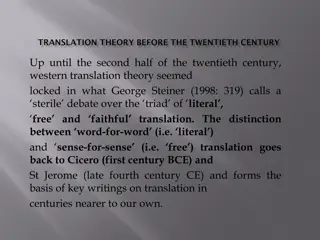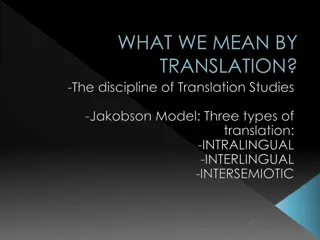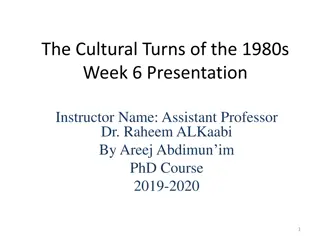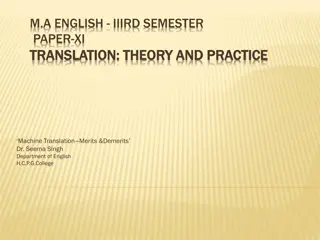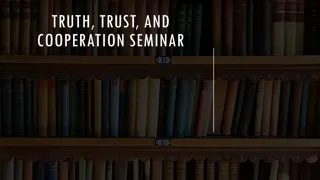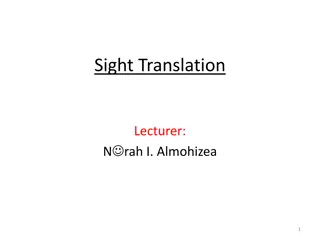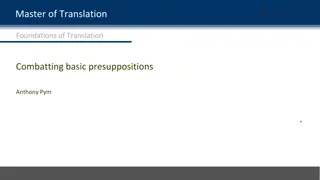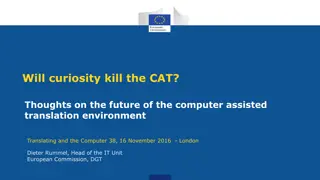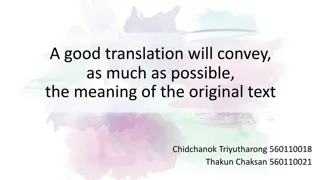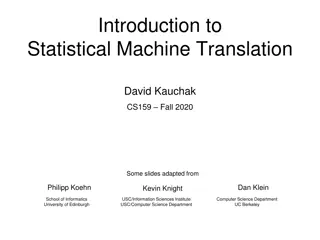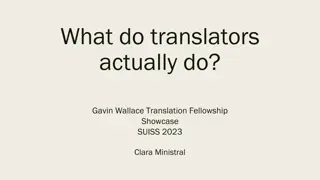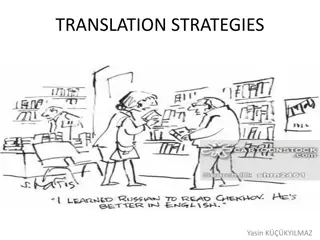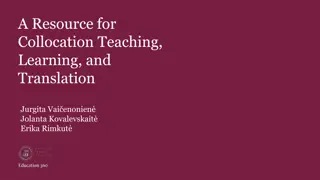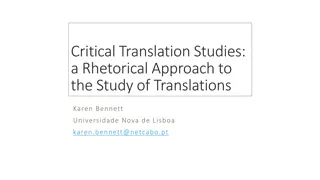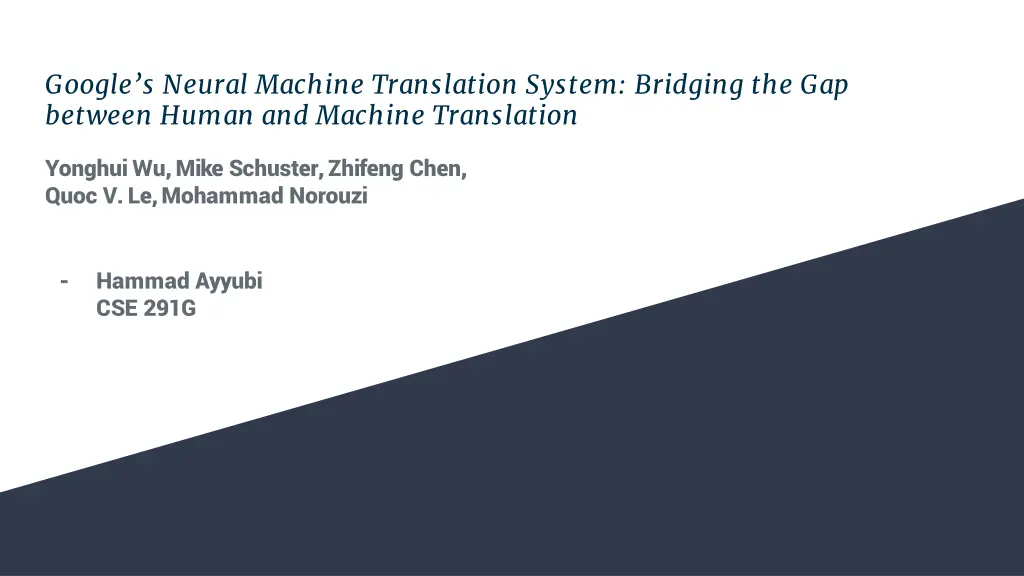
Neural Machine Translation: Bridging Human-Machine Gap
Delve into Google's Neural Machine Translation System as it tackles challenges in machine translation at scale, from slow training speeds to addressing rare words and incomplete coverage. Explore key contributions like utilizing deeper networks, addressing training speeds and rare words using Word Piece Model, and refining training strategies with Reinforcement Learning.
Download Presentation

Please find below an Image/Link to download the presentation.
The content on the website is provided AS IS for your information and personal use only. It may not be sold, licensed, or shared on other websites without obtaining consent from the author. If you encounter any issues during the download, it is possible that the publisher has removed the file from their server.
You are allowed to download the files provided on this website for personal or commercial use, subject to the condition that they are used lawfully. All files are the property of their respective owners.
The content on the website is provided AS IS for your information and personal use only. It may not be sold, licensed, or shared on other websites without obtaining consent from the author.
E N D
Presentation Transcript
Googles Neural Machine Translation System: Bridging the Gap between Human and Machine Translation Yonghui Wu, Mike Schuster, Zhifeng Chen, Quoc V. Le, Mohammad Norouzi - Hammad Ayyubi CSE 291G
Contents Challenges for MT at scale Related Work Key Contributions of the paper Main Ideas -details Experiments And Results Strengths of the paper Possible extensions Current state of MT
Challenges for MT at scale Slow training and inference speeds -bane of RNNs.
Challenges for MT at scale Inability to address *Rare words Named entities -Barack Obama (English; German), (Russian) Cognates and Loanwords -claustrophobia (English), Klaustrophobie (German) Morphologically complex words -solar system (English), Sonnensystem (Sonne + System) (German) Failure to translate all words in the source sentence -poor coverage. *Given a french sentence which was supposed to say: The US did not attack the EU! Nothing to fear, The translated sentence we got: The US attacked the EU! Fearless. *Sennrich, R., Haddow, B., and Birch, A. Neural machine translation of rare words with subword units. *Has AI surpassed humans at translation? Skynet Today
Related Work Addressing Rare words: S bastien, J., Kyunghyun, C., Memisevic, R., and Bengio, Y. On using very large target vocabulary for neural machine translation. Costa-Juss , M. R., and Fonollosa, J. A. R. Character-based neural machine translation. CoRR abs/1603.00810 (2016). Chung, J., Cho, K., and Bengio, Y. A character-level decoder without explicit segmentation for neural machine translation. arXiv preprint arXiv:1603.06147 (2016). Addressing incomplete coverage: Tu, Z., Lu, Z., Liu, Y., Liu, X., and Li, H. Coverage-based neural machine translation. In Proceedings of the 54th Annual Meeting of the Association for Computational Linguistics (2016).
Key Contributions of the paper Uses deeper/bigger network - We need to go deeper. Addresses training speed and inference speed using a combination of architectural modifications, usage of TPUs and model quantization. Addresses rare words issue using Word Piece Model (Sub-word units). Addresses source sentence coverage using modified beam search. Refined training strategy based on Reinforcement Learning.
Encoder RNN here is LSTMs. Only bottom layer is bi-directional. Each layer is placed on separate GPUs (Model Parallelism). Layer (i+1) can start computation before layer i has finished.
Decoder Produces output y_i which then goes through softmax. Output from only the bottom layer is passed to attention module.
Attention Module AttentionFunction : A feed-forward linear layer with 1024 nodes
Model Input (Addressing Rare words) Wordpiece Model Breaks words into sub-words (wordpieces) using a trained wordpiece model. Word: Jet makers feud over seat width with big orders at stake wordpieces: _J et _makers _fe ud _over _seat _width _with _big _orders _at _stake Adds _ at the beginning of each word so to recover word sequence from wordpieces. While decoding, model produces a wordpiece sequence from which the corresponding sentence is recovered.
Wordpiece Model Initialize word unit inventory with all the basic unicode characters along with all ASCII characters. Build language model on the word unit inventory. Generate a new word unit inventory by combining two units from current word inventory. Include the new word unit from all possible ones which increases the language modelling likelihood the most. Continue increasing the word inventory until a pre-specified number of tokens D is reached. Inference Reduce input to sequence of characters. Traverse inverse binary tree to get sub-words. Common Practice Using a number of optimizations -considering likely tokens only, parallelizations etc. Same word inventory for both encoder and decoder language.
Training Criteria Maximum Likelihood Training Doesn t reflect the reward function -BLEU score. Doesn t order sentences according to their BLEU scores -higher BLEU gets higher prob. Thus, isn t robust to low BLEU score erroneous sentences.
RL Based Training Objective denotes per sentence score, calculated over all the output sentences. BLEU score is for corpus text. Thus, use GLEU score -minimum of recall and precision over n- grams of 1,2,3 or 4 grams. Stabilization First train using ML objective and then refine using RL objective.
Model Quantization Model Quantization: Reducing high-precision floating point arithmetic to low-precision integer arithmetic (approximation). For matrix operations etc. Challenge: Amplification of quantization (approximation) error as you go deeper into the network. Solution: Add additional model constraints while training. This ensures the quantization error is small. Clip value of accumulators to small values
Model Quantization Question: If you are clipping values, would training be affected? Answer: No -emperically.
Model Quantization So, we have clipped accumulators during training to enable model quantization. How do we do it during inference?
Model Quantization Result on CPU, GPU and TPU Interesting question: Why GPU takes more time than CPU?
Decoding - addressing coverage Use beam search to find the output sequence Y that maximizes a score function Issues with vanilla beam search: Prefers shorter sentence as probability of sentence keeps reducing on addition of sequences. Doesn t ensure coverage of source sentence. Solution: Length Normalization Coverage Penalty
Decoding - Modified Beam Search WMT 14 En -> Fr BLEU scores Larger values of alpha and beta increase BLEU score by 1.1
Experiments and Results Datasets: WMT En -> Fr Training set consists of 36M English-French sentence pairs. WMT En -> De Training set consists of 5M English-German sentence pairs. Google Production Dataset 2-3 decimal order magnitudes larger than WMT
Experiments and Results Evaluation on RL refined model.
Experiments and Results Evaluation on ensemble model (8).
Experiments and Results Evaluation with side-by-side human evaluation on 500 samples from newstest2014. Question: Why is the BLEU score high but Side-by-side score low for NMT after RL?
Experiments and Results Evaluation on Google Production Data
Strengths of the Paper Show deeper LSTMs with skip connections work better. Better performance of WordPiece model to address the challenge of rare words. RL refined training strategy. Model quantization to improve speed. Modified beam search -length normalization and coverage penalty improves performances.
Discussions/Possible Extensions Show deeper LSTMs work better. Despite the fact that LSTMs size scale with size of input, Google can train it fast and iterate experiments using multiple GPUs and TPUs. What about lesser mortals (non-Google, non-FB people) like us? Depth matters -agreed. Can we determine depth dynamically?
Current state of MT- A peek into the future Universal Transformers: Mostafa Dehghani, Stephan Gouws, Oriol Vinyals, Jakob Uszkoreit, ukasz Kaiser
Synthesis What is BLEU? Universal Transformer What is MT? Attention Google NMT
Thank you! Questions? Tdfafdfahank




